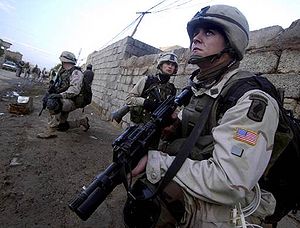USA's Military Operation during the Iraq War
Operation Bayonet Lightning was a military operation during the early stages of the Iraq War, that was held to capture weapons, materials, and people who posed a threat against coalition forces. The joint operation between Iraq and the United States, lasted approximately 16 hours, and was conducted on 2 December 2003. 1,200 soldiers from the 173rd Airborne Brigade, the 4th Infantry Division, and Iraqi military participated. Operation Bayonet Lightning was concentrated on Al Hawija, Iraq, and the village of Rashad, Iraq, sixty kilometers, or thirty-seven miles, to the south of Kirkuk, Iraq.[1]
Overview
During Operation Bayonet Lightning, coalition forces located and confiscated sixty-two AK-47 assault rifles, two hundred rounds of AK-47 ammunition, one rocket propelled grenade launcher and two improvised explosive device-making kits.
Twenty six individuals were captured, including three targeted individuals, Saad Mohammed ad-Douri, the private secretary of Izzat Ibrahim ad-Douri, and Hamid Saad, a senior official of Saddam Hussein's former ruling Ba'ath Party in charge of youth and student affairs, and a former general of the disbanded Iraqi Army.
Operation Bayonet Lightning followed Operation Rifles Blitz and was followed by Operation Bulldog Mammoth.
References
External links
|
|
Overview |
|---|
| Key events | |
|---|
Invasion
(2003) | |
|---|
Occupation
(2003–2011) | |
|---|
|
|
|
|---|
| Countries | |
|---|
Insurgent
groups | Sunni
groups | |
|---|
Shia
groups | |
|---|
Ba'ath
loyalists | |
|---|
|
|---|
|
|
|
|---|
| Operations | | 2003 | |
|---|
| 2004 | |
|---|
| 2005 | |
|---|
| 2006 | |
|---|
| 2007 | |
|---|
| 2008 | |
|---|
| 2009–2011 | |
|---|
|
|---|
| Battles | | 2003 | |
|---|
| 2004 | |
|---|
| 2005 | |
|---|
| 2006 | |
|---|
| 2007 | |
|---|
| 2008 | |
|---|
| 2009–2011 | |
|---|
|
|---|
| Related events | |
|---|
|
|
War crimes |
|---|
| Occupation forces | Killings and
massacres | |
|---|
Chemical
weapons | |
|---|
Torture
and abuse | |
|---|
|
|---|
§ Other killings
and bombings | | 2003 | |
|---|
| 2004 | |
|---|
| 2005 | |
|---|
| 2006 | |
|---|
| 2007 | |
|---|
| 2008 | |
|---|
| 2009 | |
|---|
| 2010 | |
|---|
| 2011 | |
|---|
|
|---|
| Other war crimes | |
|---|
| Prosecution | |
|---|
§ All attacks listed in this group were either committed by insurgents, or have unknown perpetrators |
|
|
Impact |
|---|
| General | |
|---|
Political
controversies | |
|---|
| Reactions | |
|---|
| Protests | |
|---|
| Aftermath in Iraq | - The rise of ISIL
- Insurgency (2011–13)
- War in Iraq (2013–17)
- War against ISIL (2014–present)
- U.S.-led intervention in Iraq (2014–2021)
- Insurgency (2017–present)
|
|---|
|
|
|
|
 Outline Outline /  Category /  Wikinews /  Multimedia |
 | This article about a military operation in the history of the United States is a stub. You can help Wikipedia by expanding it. |

 United States
United States Iraq Iraq
Iraq Iraq Iraqi insurgency
Iraqi insurgency
















